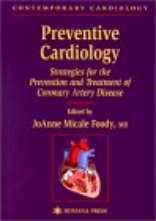|
|
|
| |
 |
|
|

|
 推薦指數:
推薦指數:





|
|
- 內容介紹
|
Preventive Cardiology: Strategies for the Prevention and Treatment of Coronary Artery Disease
by Joanne Micale, Md. Foody (Editor), Eugene Braunwald
Hardcover - 366 pages 1st edition (January 15, 2001)
HumFrom the New England Journal of Medicine, September 20, 2001
Preventive Cardiology covers the care of persons with risk factors for coronary disease. The editor is a major contributor to the field; all of her 27 coauthors are from the United States, and more than half are from the Cleveland Clinic. Their advice derives solely from U.S. guidelines, which may seem parochial to readers elsewhere.
The book illustrates the long-overdue swing from treatment toward prevention of coronary heart disease (CHD). Medical and allied professions have been slow to take up preventive measures against CHD, favoring interventional measures instead. The message of this book is timely: if the cost of treating a myocardial infarction is $75,000, let alone the devastating personal costs, time and effort devoted to prevention will be well spent.
The necessity of secondary prevention after coronary events is fully accepted, but implementation is still lacking, with wide variations across the United States and Europe. A recent comparison of post-myocardial infarction data from 1995 with data from 2000 shows that obesity and inactivity increased, the incidence of smoking was unchanged, the treatment of hypertension remained inadequate, and only 65 percent of the patients were taking lipid-lowering therapy. The information in this book should help to counteract inaction.
Physicians are able to follow guidelines for secondary prevention, but those for primary prevention are less well understood, particularly in the United States, although the recommendations of the Adult Treatment Panel III of the National Cholesterol Education Program address the global risk of CHD. They identify asymptomatic persons at high risk who would benefit from drug therapy, a task that has also been completed in Europe.
The thrust of the book is to remind us to use all the interventions we have available. The authors of three particularly good chapters on exercise, obesity, and tobacco point out that preventive efforts are more aggressively pursued when they involve drug therapy. There is an interesting discussion of the change in attitudes toward smoking prevention that followed lawsuits involving tobacco companies.
The success of the other chapters in the section on the treatment of risk factors varies. That of Foody, on dyslipidemia, is exhaustive in its review of the statins and other trial data. It commendably discusses triglyceride levels as a risk factor but contains disappointingly little on the association of Lp(a) lipoprotein and CHD, an intriguing relation that is increasingly supported by data. On hypertension, Vidt is more succinct; he points out that the age-adjusted rate of stroke in the United States has increased, as has the rate of end-stage renal disease, indicating a shameful shortfall in treatment. He also makes a plea for physicians to be aware of the total risk for CHD when a patient is starting therapy. Since statins have become the preferred treatment for reducing the risk of CHD, it may be that patients have become less aware that hypertension requires treatment, and guidelines on antihypertensive medication have not been followed.
|
|
|

